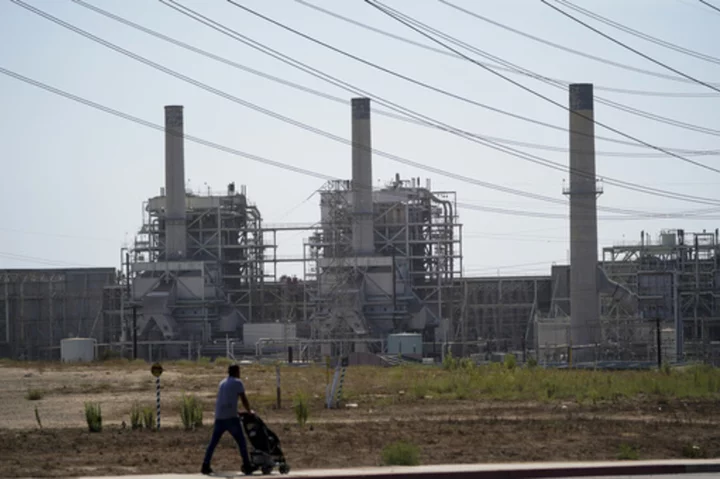SACRAMENTO, Calif. (AP) — Temperatures in many California cities are cooling down this week, but a debate is simmering on how to generate enough electricity to power the state through extreme weather events while transitioning away from a reliance on fossil fuels.
The California Energy Commission voted Wednesday to extend the life of three gas power plants along the state's southern coast through 2026, postponing a shutoff deadline previously set for the end of this year. The vote would keep the decades-old facilities — Ormond Beach Generating Station, AES Alamitos and AES Huntington Beach — open so they can run during emergencies.
The state is at a greater risk of blackouts during major events when many Californians simultaneously crank up their air conditioning, such as a blistering heat wave.
“We need to move faster in incorporating renewable energy. We need to move faster at incorporating battery storage. We need to build out chargers faster,” commissioner Patricia Monahan said. “We're working with all the energy institutions to do that, but we are not there yet.”
The plan, put together by the state’s Department of Water Resources, still needs final approval from the State Water Resources Control Board, which may vote on the issue next week. Democratic Gov. Gavin Newsom signed legislation last year creating an energy reserve the state could use as a last resort if there is likely to be an energy shortage. The law allowed the Department of Water Resources to fund or secure power sources in those instances.
The commission acknowledged it was a difficult decision. Environmentalists say the state needs to transition to more short- and long-term solutions that will help it move away from fossil fuels and to rely more on renewable energy sources like solar and wind. They’re also concerned about the health impacts associated with pollution from gas plants.
Few people spoke in support of keeping the plants open during about three hours of public comment.
Neither GenOn, the company running the Ormond Beach plant, nor AES, which runs the Alamitos and Huntington Beach plants, responded to email requests for comment on the vote.
At Wednesday's meeting, activists said residents cannot be sure the state will not decide to again extend the life of these plants in another three years. Siva Gunda, the commission's vice-chair, said the state should better prepare a strategy for ending operations of the plants by 2026.
The three plants were originally set to shut down in 2020 under state regulations aimed at power plants that suck up ocean water to cool down their equipment. Many similar power plants have already shut down to comply with those rules.
The Ormond Beach plant is located in a largely Latino, low-income part of Oxnard, a city about 54 miles (87 kilometers) west of Los Angeles, next to agricultural fields that border homes. Oxnard residents who testified at the meeting said they are concerned about respiratory illnesses associated with pollution from gas facilities, as well as odors and noises coming from the plant.
“We are tired of fighting for our human right to breathe clean air,” said Oxnard resident and activist Sofi Magallon.
Newsom said earlier this year that the state would have enough water in its reservoirs from intense periods of snow and rain this past winter to revive hydroelectric plants, which reduces the chances of electricity outages during heat waves.
Emissions from the three plants dramatically increased during a record-breaking September heat wave, according to a report released by Regenerate California, a coalition of environmental groups. That included pollution from carbon and smog-forming nitrogen oxides. The report also cites data from the state showing that several gas plants didn't generate as much electricity as expected during the heat wave.
“They're not providing the energy that we're relying on them for. They're overpromising and underdelivering,” said Ari Eisenstadt, an energy equity manager with the California Environmental Justice Alliance. “That makes them a pretty bad investment.”
California has made strides in recent years to move toward renewables. In 2021, more than 37% of the state’s electricity came from renewable sources, up nearly 3% from the previous year, according to the Energy Commission. The state has set out to remove as many carbon emissions from the atmosphere as it emits by 2045.
But environmentalists still want California to speed up its transition toward renewables like solar and wind. In the meantime, the state should spend “much more ambitiously” to fund programs incentivizing people to reduce their energy use, so resources are not strained during extreme heat, said Teresa Cheng, a campaigner with Sierra Club.
That includes a statewide program to pay people to conserve energy during peak electricity times.
During last September's heat wave, Newsom issued something called a Flex Alert, which asked Californians to use less energy during the evenings in part by setting their thermostats to 78 degrees Fahrenheit (26 degrees Celsius) or higher. The result was a dramatic reduction in reliance on the grid, Cheng said.
“There's always this crux of being able to extend the life of gas plants,” Cheng said. “As long as we have these gas plants online, we never really have to invest in clean energy solutions.”
___
Sophie Austin is a corps member for the Associated Press/Report for America Statehouse News Initiative. Report for America is a nonprofit national service program that places journalists in local newsrooms to report on undercovered issues. Follow Austin on Twitter: @sophieadanna.

